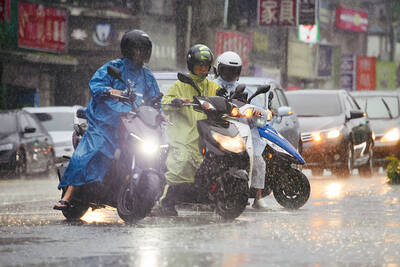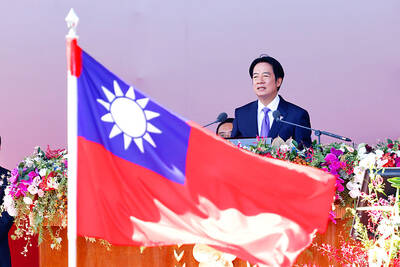A Dassault Mirage 2000 fighter jet crashed yesterday evening during a training mission over the seas north of Taiwan, the Air Force Command said.
At press time last night, a military search-and-rescue helicopter team was still looking for the pilot, Captain Ho Tzu-yu (何子雨) of the 499th Tactical Fighter Wing, the air force said.
The lost fighter, tail code 2040, took off from Hsinchu Air Base yesterday evening for a training mission, it said.

Photo: Chang Chung-i, Tapei Times
At 6:43pm, the jet was flying near Pengjia Islet, about 40 nautical miles (74km) from Keelung, when it vanished from radar and air controllers lost contact with the pilot.
Sikorsky S-70C helicopters were launched at 7:05pm to conduct search-and-rescue operations over the fighter’s last known location and the coast guard was informed of the missing plane.
Ho, 28, was inducted into the air force pilot school in 2011 and has a good military record, the air force said, adding that he has logged 419 flight hours in the Mirage 2000 out of 718 total flight hours.
The nation in 1989 reached an agreement with France to buy 60 Dassault Mirage 2000 fighters, which were delivered in 1998.
Before yesterday, four fighters had been lost in accidents, in October and December 1999, November 2001 and May 2013.
Three Mirage 2000 pilots perished in those accidents, while five survived.
In addition, a Mirage 2000 fighter tail, coded 2057, was set on fire after a suspected bird strike, but the pilot escaped alive and the aircraft was fully repaired.
The cause of the crash was unknown.

The combined effect of the monsoon, the outer rim of Typhoon Fengshen and a low-pressure system is expected to bring significant rainfall this week to various parts of the nation, the Central Weather Administration (CWA) said. The heaviest rain is expected to occur today and tomorrow, with torrential rain expected in Keelung’s north coast, Yilan and the mountainous regions of Taipei and New Taipei City, the CWA said. Rivers could rise rapidly, and residents should stay away from riverbanks and avoid going to the mountains or engaging in water activities, it said. Scattered showers are expected today in central and

People can preregister to receive their NT$10,000 (US$325) cash distributed from the central government on Nov. 5 after President William Lai (賴清德) yesterday signed the Special Budget for Strengthening Economic, Social and National Security Resilience, the Executive Yuan told a news conference last night. The special budget, passed by the Legislative Yuan on Friday last week with a cash handout budget of NT$236 billion, was officially submitted to the Executive Yuan and the Presidential Office yesterday afternoon. People can register through the official Web site at https://10000.gov.tw to have the funds deposited into their bank accounts, withdraw the funds at automated teller

COOPERATION: Taiwan is aligning closely with US strategic objectives on various matters, including China’s rare earths restrictions, the Ministry of Foreign Affairs said Taiwan could deal with China’s tightened export controls on rare earth metals by turning to “urban mining,” a researcher said yesterday. Rare earth metals, which are used in semiconductors and other electronic components, could be recovered from industrial or electronic waste to reduce reliance on imports, National Cheng Kung University Department of Resources Engineering professor Lee Cheng-han (李政翰) said. Despite their name, rare earth elements are not actually rare — their abundance in the Earth’s crust is relatively high, but they are dispersed, making extraction and refining energy-intensive and environmentally damaging, he said, adding that many countries have opted to

PEACE AND STABILITY: Maintaining the cross-strait ‘status quo’ has long been the government’s position, the Ministry of Foreign Affairs said Taiwan is committed to maintaining the cross-strait “status quo” and seeks no escalation of tensions, the Ministry of Foreign Affairs (MOFA) said yesterday, rebutting a Time magazine opinion piece that described President William Lai (賴清德) as a “reckless leader.” The article, titled “The US Must Beware of Taiwan’s Reckless Leader,” was written by Lyle Goldstein, director of the Asia Program at the Washington-based Defense Priorities think tank. Goldstein wrote that Taiwan is “the world’s most dangerous flashpoint” amid ongoing conflicts in the Middle East and Russia’s invasion of Ukraine. He said that the situation in the Taiwan Strait has become less stable